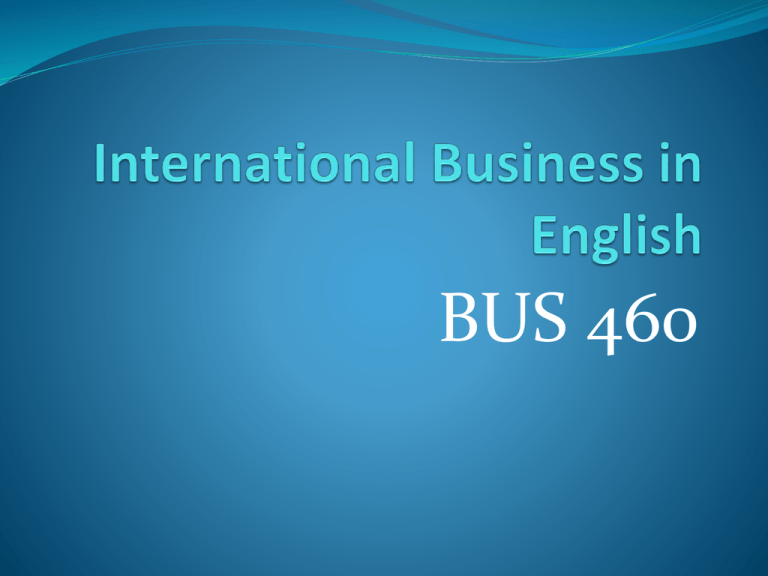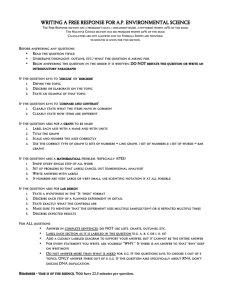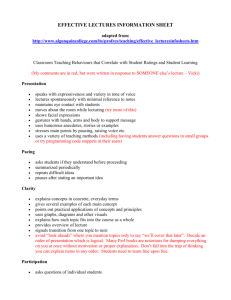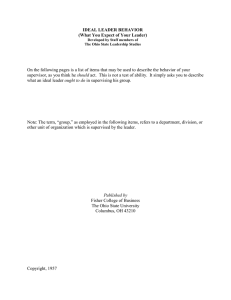International Business in English
advertisement

BUS 460 INTERNATIONAL STRATEGY Introduction: The end of product of strategic decisions is deceptively simple; a combination of products and markets is selected for the firm. How companies begin to decide which products to sell overseas, and which markets to target? As commercial organization, the driving force will be the need to increase profits and the market value of the company, And so care must be made taken to avoid expensive mistakes. Introduction: One way of minimizing the risk of making a strategic mistake is construct a detailed matrix of alternative product and market combinations, And to formally assess each alternative. The criteria for assessment will reflect management’s attitude to risk, their priorities, and their understanding of current market and competitive conditions. The final selection that is made at board level represents t he strategy for the organization. Stages in the Strategic Planning Process The strategic planning process shows that strategies need to be developed at a number of different levels within a company. It is therefore helpful to begin consideration of international strategy with a clarification of the different levels of strategy within any organization. Levels of Strategy It is the responsibility of senior management to ensure strategic consistency ) (توافقacross different sections of a company. Consequently, it is helpful to understand the distinction between corporate, business and functional strategies. Levels of Strategy 1- Corporate Strategy : asks the question: what should be our portfolio of business. 2- Business Strategy: asks the question: how do we compete? 3- Functional Strategy: asks the question: how does this function, e.g. marketing need to be organized so that business and corporate strategies are fulfilled? Is International Strategy Any Different? Yes and No. Yes, because it involves analysis of a more complex environment. No, because ultimately is still has the same aim – identification of a competitive advantage. Let us look at each of these issues in a little more detail. The product / market choice at an international level is made more complex because of the greater level of information required to make informed decisions. Is International Strategy Any Different? The different geographic regions of the world exhibit political, cultural, legal and economic differences all of which have both strategic and operational implications. Good background research is required by companies to ensure that they understand the new market they are entering. Is International Strategy Any Different? Differences between international and domestic operations which may have strategic implications include: 1- Cost structure of operations: Wage rates in Germany are higher than in the UK, which means that the cost structure of overheads: direct costs will not be the same for the German and UK plant of BMW / Rover, even though they may be producing the same motors. Is International Strategy Any Different? 2- Competitive strategies: Local forms of competition may vary. Example: it is suggested that penetration of Japanese markets is very difficult because of difficulty of accessing distribution outlets for consumer goods: Control of competition takes the form of access to customers. Is International Strategy Any Different? 3- Organizational structure and control systems: Companies may need to be more flexible in specifying performance measures for international operations than it would be in the domestic environment. Going International – Why Bother? So far we have reached a point at which it is possible to conclude: 1- Strategy is concerned with competitive advantage. 2- Functional and general strategies need to be fully integrated. 3- Formulation of an international strategy can present additional challenges to management. 4- The extent of variations in strategies across national boundaries is dependent upon the type of product / service. Reasons for Internalisation All companies are different, and so the precise reasons for internationalizing will vary across organizations to reflect their individual circumstances. Nonetheless, a number of common themes emerge, which highlight a mix of factors seen as influencing the decision to sell or produce internationally. Table 5.2 summarized factors influencing the internationalization of a company مت حبمد هللا THE END





















